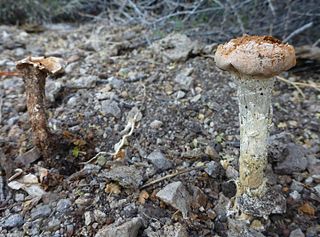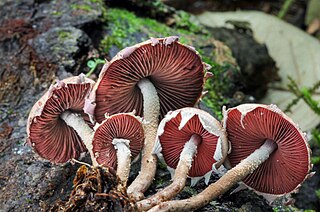Related Research Articles

Lycoperdon is a genus of puffball mushrooms. The genus has a widespread distribution and contains about 50 species. In general, it contains the smaller species such as the pear-shaped puffball and the gem-studded puffball. It was formerly classified within the now-obsolete order Lycoperdales, as the type genus which, following a restructuring of fungal taxonomy brought about by molecular phylogeny, has been split. Lycoperdon is now placed in the family Agaricaceae of the order Agaricales.

Lepiota is a genus of gilled mushrooms in the family Agaricaceae. All Lepiota species are ground-dwelling saprotrophs with a preference for rich, calcareous soils. Basidiocarps are agaricoid with whitish spores, typically with scaly caps and a ring on the stipe. Around 400 species of Lepiota are currently recognized worldwide. Many species are poisonous, some lethally so.

The Agaricaceae are a family of basidiomycete fungi and include the genus Agaricus, as well as basidiomycetes previously classified in the families Tulostomataceae, Lepiotaceae, and Lycoperdaceae.

Coprinus is a small genus of mushroom-forming fungi consisting of Coprinus comatus—the shaggy ink cap (British) or shaggy mane (American)—and several of its close relatives. Until 2001, Coprinus was a large genus consisting of all agaric species in which the lamellae autodigested to release their spores. The black ink-like liquid this creates gave these species their common name "ink cap" (British) or "inky cap" (American).

Echinoderma is a genus of fungi in the family Agaricaceae. Its members were for a long time considered to belong to genus Lepiota and the group was then circumscribed by French mycologist Marcel Bon in 1981 as a subgenus of Cystolepiota before he raised it to generic status in 1991.

The Psathyrellaceae are a family of dark-spored agarics that generally have rather soft, fragile fruiting bodies, and are characterized by black, dark brown, rarely reddish, or even pastel-colored spore prints. About 50% of species produce fruiting bodies that dissolve into ink-like ooze when the spores are mature via autodigestion. Prior to phylogenetic research based upon DNA comparisons, most of the species that autodigested were classified as Coprinaceae, which contained all of the inky-cap mushrooms. However, the type species of Coprinus, Coprinus comatus, and a few other species, were found to be more closely related to Agaricaceae. The former genus Coprinus was split between two families, and the name "Coprinaceae" became a synonym of Agaricaceae in its 21st-century phylogenetic redefinition. Note that in the 19th and early 20th centuries the family name Agaricaceae had far broader application, while in the late 20th century it had a narrower application. The family name Psathyrellaceae is based on the former Coprinaceae subfamily name Psathyrelloideae. The type genus Psathyrella consists of species that produce fruiting bodies which do not liquify via autodigestion. Psathyrella remained a polyphyletic genus until it was split into several genera including 3 new ones in 2015. Lacrymaria is another genus that does not autodigest its fruiting bodies. It is characterized by rough basidiospores and lamellar edges that exude beads of clear liquid when in prime condition, hence the Latin reference, lacryma (tears).

Podaxis is a genus of secotioid fungi in the family Agaricaceae. Species, which have the appearance of a "stalked-puffball", have a worldwide distribution, and tend to be found growing solitary or scattered on sandy soils, especially in arid regions. Although close to 50 species have been described, it has been argued that many of them may represent extremes in the natural range of variations found in Podaxis pistillaris.
Mycocalia is a genus of fungi in the family Agaricaceae. Their fruit bodies resemble tiny egg-filled birds' nests. Species are usually found growing on herbaceous stems and other plant debris. Thus genus was circumscribed in 1961 by mycologist J.T. Palmer with Mycocalia denudata as the type species.

Chlamydopus is a genus of fungi in the family Agaricaceae. It was circumscribed by Carlos Luigi Spegazzini in 1898.

Clavogaster is a genus of gasteroid fungi in the family Agaricaceae. The genus was circumscribed by German mycologist Paul Christoph Hennings in 1896 to contain the type species Clavogaster novozelandicus, which is now a synonym of Clavogaster virescens.

Gastropila is a genus of fungi in the family Agaricaceae. The genus, described in 1973, contains four puffball-like species distributed in the Americas.
Hiatulopsis is a genus of two species of fungi in the family Agaricaceae. The genus was circumscribed in 1967 by mycologists K. Grinling and Rolf Singer with H. amara as the type species. H. aureoflava was added to the genus by Singer in 1989.
Janauaria is a fungal genus in the family Agaricaceae. This is a monotypic genus, containing the single species Janauaria amazonica, found in Brazil and described as new to science in 1986 by mycologist Rolf Singer.

Leucoagaricus is a genus of fungi in the family Agaricaceae. Several fungus-growing ants cultivate multiple species for food. The genus contains approximately 90 species.

Melanophyllum is a genus of fungi in the family Agaricaceae. The widespread genus contains four species.

Panaeolopsis is a genus of fungi in the family Agaricaceae. The genus has a widespread distribution and contains four species. Panaeolopsis was circumscribed by Rolf Singer in 1969 with P. sanmartiniana as the type species.
Phlebonema is a fungal genus in the family Agaricaceae. It is a monotypic genus, containing the single species Phlebonema chrysotingens, described by Roger Heim in 1929 from Madagascar. According to the Dictionary of the Fungi, the placement of this little-known genus in the Agaricaceae is uncertain.

Coniolepiota is a fungal genus in the family Agaricaceae. The genus is monotypic, containing only a single species, Coniolepiota spongodes. It was first described from Thailand, and later also reported from Bangladesh and China.
Eriocybe is a fungal genus in the family Agaricaceae. Circumscribed by mycologist Else Vellinga in 2011, it is a monotypic genus, containing the single species Eriocybe chionea, found in northern Thailand. The genus name is derived from the Ancient Greek words ἔριον, meaning "wool" and κύβη, "head". The specific epithet comes from the Latin translation of the Greek χιόνεος, meaning "snow white".
References
- ↑ Hennings P. (1900). "Fungi monsunenses". Monsunia. 1: 137–174 (see p. 158).